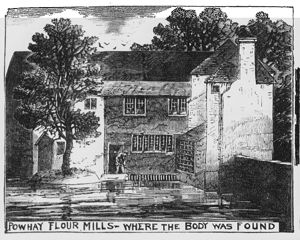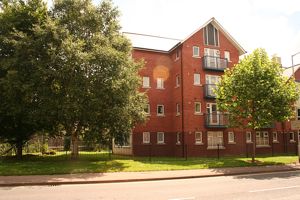
Powhay Mills
Also known as Bonhay Mills
Page updated 5th January 2013
The site of Powhay Mills is now a block of residential housing unsurprisingly known as Powhay Mills.
The earliest record of a mill on the site is from 1422, when an account shows one John Austyn paying the sum of 26s 8d to the Earl of Devon for corn mills in Boghenhay, along with 20s for a newly built corn mill at the same site. By 1577 there were two grist and a single malt mill. Owned by the City, the mills were let in reversion for a fine (charge) of £700 to George Pyle in 1624. Through the 17th-Century, the mill was modified from time to time, and a major rebuild commenced in 1667, for Mrs Pyle. The complex now consisted of three grist mills, a malt mill and two fulling mills; this was a time when Bonhay was full of rack fields for drying the cloth.
The structure of a mill was very fluid at this time and rebuilds and change of uses were fairly easy to accomplish as the main buildings were often built of timber with a solid, stone base, and stone walls to support the wheels. It was also common to add or remove millstones, fulling stocks, and even wheels, according to the latest requirements. By 1758, the mill had four wheels, all driven by the Lower Leat. Two were on opposite banks, one directly below one of the above wheels, and even lower down the leat, a central wheel. These four wheels drove four grist mills, one malt mill and two fulling mills. Two or even three millstones could be driven by one wheel through gearing.
The earliest reference to the name Powhay Mill was in 1727, in papers that were drawn up for a legal dispute. In 1785, the Sherbourne Mercury noted that there were four corn mills, and five fulling mills, all driven from two wheels. By the third decade of the 19th Century, Powhay was run as a grist or flour mill; in April 1817 there was a to let or sale notice for a mill with five fulling stocks adjoining the existing flour mill run by Mr James Strong. Mr Strong lived at 96 Fore Street where he ran a baking and confectionery business, doubtless, supplied with flour from his mill. Mr Strong was also involved in other speculative trades, such as importing timber from St John's New Brunswick which was landed at Bonhay during 1819. Robson's Directory of Devon for 1839 has James Strong listed as running a bone mill for fertiliser from Powhay.
By 1849, James Strong and Son divested itself of the Fore Street business and in 1854, Powhay Mill was offered for sale as a snuff or fulling mill. The mill remained as a flour mill, for in 1856, Mr Kemp won the tender for supplying flour at £2 18s 10d a sack for the Exeter Corporation of the Poor. It is not certain if Kemp owned or leased the mill but in May 1869, the mortgagees instructed that the mill and other local properties, including the newly completed St Edmund's Square be sold. A month later and the new owner, Mr John Carthew, of Four Mills, Crediton advertised the mill for let. The premises consisted of three waterwheels, nine pairs of French millstones, four silk flour dressers, and a smut machine used for cleaning wheat, all of the newest kind.
The mill was for let again in 1877, when it was stated it could produce 500 sacks of flour per week, weighing 63½ tons, from three wheels. Mr Edmund Brown was the new miller, and he soon made an impression when he chaired an Exeter millers meeting on the standardisation of the weight of a sack of flour. By July 1882, he was president of the Devon County Millers Association and seemed set fair to become a man of influence, when, in July 1885, he was declared bankrupt.
Annie Tooke
In May 1879, the torso of a 8 month old baby boy was found by Edward Stookes, in the grid of the mill leat beneath Powhay Mills. The leat was drained and the head was found at the rear of the city brewery, while the arms and legs were in the leat near the Shakespeare Inn. The body parts were taken to the Princess Alexandra Inn, just opposite Powhay. A woman named Anne Tooke was arrested, found guilty and hung in August 1879, for the child's murder in one of the most sensational trials of the 19th Century.
The British Architect magazine reported in June 1885 that drawings and specifications, for altering and enlarging Powhays Mill, could be obtained from Mr J Jerman, architect and surveyor of 33 Paul Street, Exeter.
All this time, the owner, Mr Carthew attended to his milling and farming interests in Crediton. It is probable when Mr Brown was bankrupted that Carthew employed a manager to run the mill as he was by then, 74 years old. Mr Carthew died in 1896 and the mill passed to his son. In June 1900 it was for auction at the Half Moon Hotel in the High Street. The sale advert said it was suitable as a flour, wool, paper or saw mill, a brewery, tannery or a dye works. By this time, Exeter had no woollen industry and there was fierce competition for milling corn, so a new use would be found for the complex, despite the fact that it had been upgraded to a roller mill.
It became, by 1904, the South Devon Ice and Cold Storage Co., where 1 cwt (50 kg) blocks of ice were produced for delivery to local butchers and fishmongers. The water wheels were taken out, and power produced for the cold store compressor by a gas engine that used both town gas, and their own gas from the producer gas process. The works were burnt down, in November 1936. See Express and Echo report and Cyril Browns's memories for more on the fire. Powhay House survived until the 1970s. Signpost Homes built the Powhay Mills apartments in 2001, providing forty four homes, which were opened by Ben Bradshaw MP.
Sources are listed in the mills menu page
 Powhay Mills in the 19th century.
Powhay Mills in the 19th century. The modern Powhay House on the site of the mill.
The modern Powhay House on the site of the mill. The Princess Alexandra public house.
The Princess Alexandra public house.
│ Top of Page│